The Fallen Shoes: Symbolism and Impact in Skateboarding
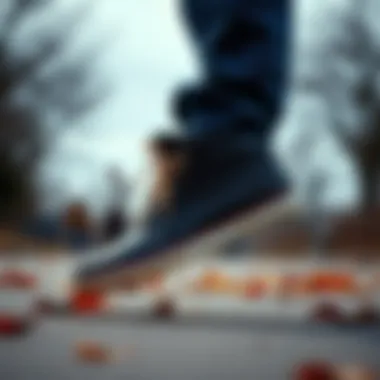
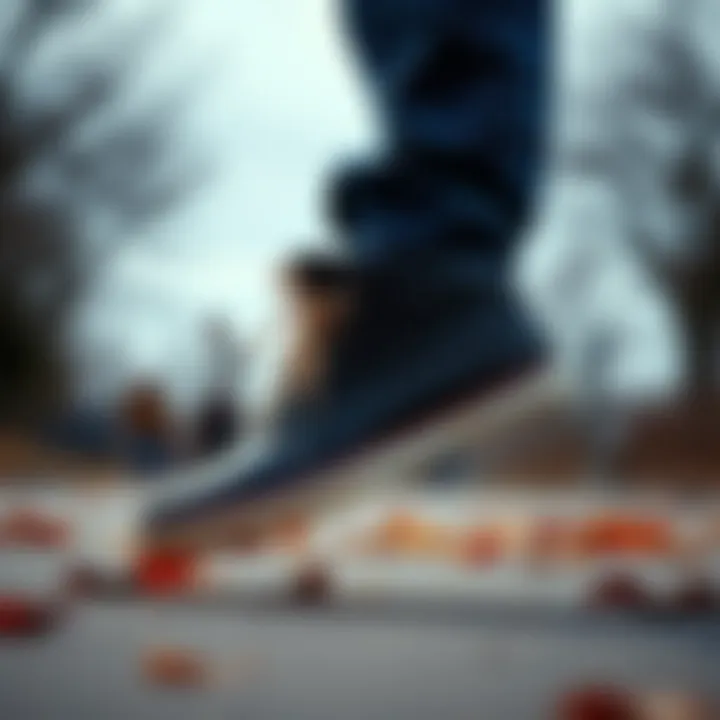
Intro
In the world of skateboarding, a pair of shoes represents more than just footwear; they embody culture, style, and even allegiance. The phenomenon of fallen shoes is worth diving into because it reflects not only the practicalities of skating but also the identity and creative expressions of those who ride. When skaters toss aside their worn-out footwear, it’s not just about worn soles—it’s a testament to the journey, the countless hours spent gliding on concrete, and the emotional investments in style and performance.
In skateboarding culture, shoes have long been symbolic artifacts. They are the silent witnesses to every push, every kickflip, and every trick learned the hard way. The markings on these shoes—scuffs, rips, and dirt—tell tales of triumph and mishaps. Each pair carries stories that transcend mere aesthetics, becoming emblematic of experiences shared among the community. The fallen shoes say something profound: they illustrate a culture forged in perseverance and creativity.
By examining the intersection of skateboarding and footwear, we uncover a treasure trove of insights about identity, community, and expression.
As we venture further into this exploration, we will look at:
- The significance of shoes in a skater's identity.
- Practical aspects of performance and what constitutes a good skating shoe.
- How cultural contexts shape perceptions of footwear.
Skateboarding has always been more than a sport; it’s a lifestyle, and fallen shoes symbolize the very essence of that lifestyle. Let's roll into the nuanced world of fallen shoes.
Understanding Fallen Shoes in Skateboarding
The symbolic weight that footwear carries in skateboarding is substantial. Fallen shoes are not just practical gear; they serve as a tapestry woven with the threads of identity, community, and personal expression. This section aims to unpack the intricate layers of what fallen shoes represent, reflecting both the culture and the individual journeys within it.
Defining fallen shoes
When we refer to ‘fallen shoes’ in the context of skateboarding, we are not merely talking about any old sneaker. These shoes are emblematic of a particular ethos that permeates the skate culture. They often bear the scars of a skater's journey—the scuff marks tell tales of sliding across concrete, while the wear and tear speak volumes of countless hours spent perfecting tricks and navigating urban landscapes. In this lens, fallen shoes can be seen as markers of achievement and personal stories, resonating with a narrative of determination and passion.
From an aesthetic standpoint, fallen shoes often denote a specific style favored by skaters, merging the practicality of performance with an element of rebellion against mainstream fashion trends. This nuanced definition highlights that these shoes are not mere fashion statements; they are stories in themselves, woven into the very essence of skateboarding culture.
Historical context of footwear in skating
To fully appreciate the significance of fallen shoes, it is essential to reflect on the historical context of footwear in skateboarding. In the early days of the sport, skate shoes were simple canvas designs often derived from surfing shoes. The equipment wasn't purpose-built but evolved to suit skaters' needs over time. As skating grew, so did the recognition of specialized footwear. Brands like Vans and Converse started catering specifically to skaters, incorporating durability and grip into their designs.
By the late 80s and into the 90s, skateboarding underwent a renaissance. Street skating exploded, and the demand for stylish yet functional shoes surged. Skate brands began to collaborate with skaters to create models that would suit both performance and aesthetic needs. It was during this period that fallen shoes began to emerge as a symbol of the push against commercialism- with some skaters wearing older, battered versions to assert a connection to authenticity and roots in the culture.
The evolution of skate shoes reflects broader trends within skateboarding. Brands embraced the individuality of skaters, resulting in personalized styles that ranged from bold designs to utilitarian aesthetics. This history underscores how fallen shoes are not just remnants of use; they are significant objects, intertwined with the community’s journey and transformation over the decades.
The Significance of Footwear in Skateboarding
The world of skateboarding is not just about the board itself; footwear plays a pivotal role in the experience. Skate shoes are an extension of a skater's identity, offering not only a means to perform tricks but also a way to express personal style and connection to the culture. In this section, we'll explore how footwear impacts performance, functionality, and cultural significance in skateboarding.
Performance and functionality
Grip and traction
One cannot understate the importance of grip and traction in skateboarding footwear. These elements are key in providing stability and control while performing maneuvers. Grip refers to the ability of the shoe's sole to adhere to the skateboard deck, allowing skaters to execute slides, flips, and other tricks without slipping off.
Most skate shoes feature rubber outsoles designed specifically for durability and grip. Many of these soles have specialized tread patterns, which improve friction between the shoe and the board, enhancing the skater's ability to land tricky tricks. Brands like Vans and Nike SB have become synonymous with high-performance grip, catering to the needs of both beginner and professional skaters.
Moreover, grip becomes more than just a practical component; it’s a vital characteristic that fosters confidence. When skaters trust their shoes, they tend to push their limits, often leading to impressive feats that deepen their connection to the sport.
Cushioning and support
In addition to grip, cushioning and support are fundamental aspects of skate shoes that directly influence performance. Skaters experience various impacts as they jump and land on the board. Cushioning helps absorb these shocks, providing comfort and reducing the risk of injury over time.
Good cushioning material allows for a soft landing, which is essential for maintaining foot health. Shoes equipped with midsole technology, like that found in many models from Adidas and DC Shoes, enhance rebound and energy return. This feature not only aids in performing better but also minimizes fatigue during long skate sessions.
Support also plays a significant role. Shoes with a higher collar can offer ankle support, which is particularly beneficial for skaters tackling street skating or vertical ramps. While support can enhance performance, it's essential not to compromise flexibility as skaters often need to maneuver quickly.
Cultural implications of shoe choices
When skaters walk into a park, their footwear speaks volumes about their tastes, stance, and even their allegiances within the skating community. Shoes are not just about convenience or functionality; they serve as identity markers in this subculture.
From the Swoosh of Nike to the sticky soles of Etnies, each brand carries with it a perception and cultural connotation. For instance, brands often collaborate with artists and skaters, creating limited editions that not only speak to style but also commemorate skater achievements or movements within the culture. The choice of footwear becomes a form of storytelling, weaving personal and collective narratives that reflect the skater's ethos.
Wearing someone's brand can also signify loyalty or rebellion against mainstream culture. Skateboarding's DIY roots foster a unique kind of freedom. Young skaters may opt for brands that convey a sense of underground and non-conformity, often steering clear of sneaker giants attached to broader retail markets. By choosing specific brands or styles, they articulate defiance against typical fashion trends, instead embracing a lifestyle that's all about individuality and expression.
"Footwear can make or break a skater's tricks, but in the grand tapestry of skate culture, they also tell a story."
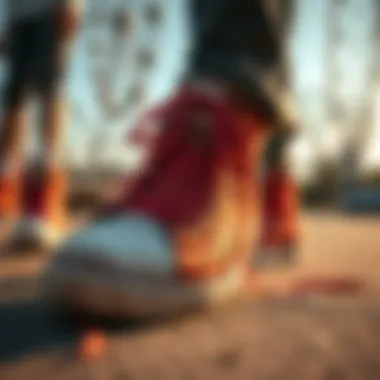
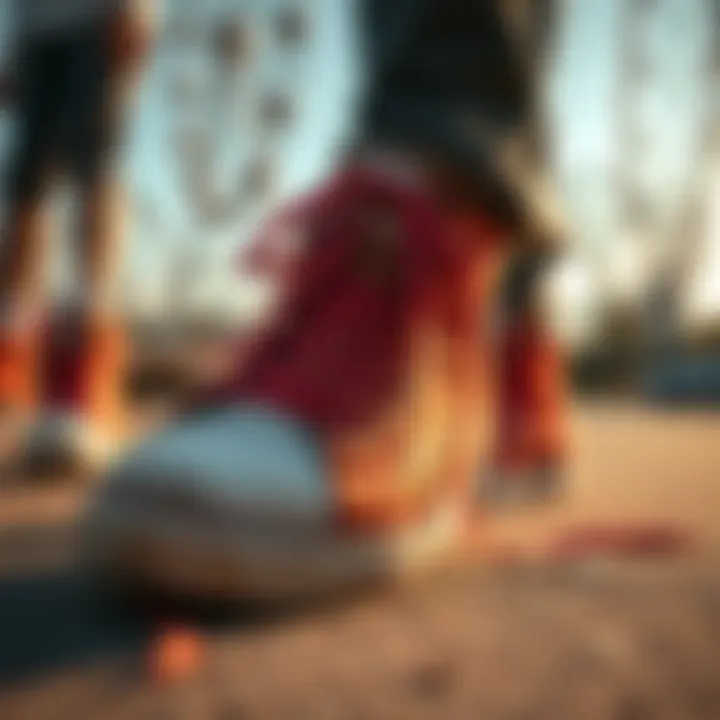
The implications of shoe choices in skateboarding culture stretch far beyond performance; they intersect with identity, community ties, and societal influences. In this rich landscape, the significance of footwear cannot be understated.
The Role of Fallen Shoes in Skater Identity
Skateboarding isn't just about the tricks you can pull off or the boards you ride. It's about the lifestyle – the ethos, the attitude, and undeniably, the shoes you lace up. For skaters, fallen shoes play a crucial role in crafting their identity. It’s not simply about utility; it’s an embodiment of self-expression and a rejection of conventional norms. Here, footwear is more than a protective layer; it's a badge of honor that whispers stories of grit, rebellion, and creativity.
Personal expression through footwear
Every skater knows that choosing a pair of shoes goes beyond simply selecting a style. It's a deep-seated form of personal expression. A skater's choice reflects not only their aesthetic tastes but also their mindset and values. For instance, a preference for minimalist designs may signal a focus on performance, while bright colors and bold graphics can hint at a desire for attention and individuality.
The concept of personal expression resonates particularly with young skaters. For them, wearing a specific brand or model can help forge connections. It’s not unusual for skaters to bond over the stickers on their shoes or the latest limited edition drop that no one else seems to have. It's like a secret code of camaraderie that reinforces their belonging within a community.
"Your shoes are a part of your vibe. They tell the world who you are without saying a word."
Moreover, the shoes one wears can serve as fashion statements. Many skaters gravitate towards classic styles that have become symbols of the culture, such as the Vans Old Skool or the Nike SB Dunk. These choices reflect a blend of admiration for the skateboarding history and a desire to carve out a unique identity within it.
Rejection of mainstream fashion
Skateboarding has always thrived on its counterculture roots. Wearing fallen shoes often reflects a conscious choice to step away from mainstream fashion trends. In a world saturated with fast fashion and fleeting trends, skaters opt for shoes that may defy the conventional standards of beauty, durability, or even price point. This rejection of the norm isn’t merely superficial; it's rooted in a desire to maintain authenticity and embrace individuality.
Skaters often find themselves at odds with the larger fashion industry, which at times may commodify their culture. Yet, there’s an inherent strength in the rebellion. Choosing fallen shoes that resonate with personal ideals signals an understanding that true style isn't about following trends but about being true to oneself.
This duality creates a fascinating dynamic within the culture. On one side, there’s an appreciation for the art of craftsmanship and a celebration of shoes that endure the rigors of skate life. On the other side, there’s an unwavering commitment to authenticity, where wearing a popular brand doesn’t automatically equate to being a part of the culture.
By aligning their identity with a rejection of the more polished mainstream, skaters pave their unique paths. Fallen shoes become a means through which they can navigate the world, illustrating their values, attitudes, and personal journeys as they glide through life on four wheels.
Fallen Shoes as a Symbol of Community
Fallen shoes resonate deeply within the realm of skateboarding culture, acting not only as a piece of equipment but as a significant emblem of community and shared values. Many skaters regard their footwear as an extension of their identity. More than a mere accessory, these shoes encapsulate a lifestyle rooted in collaboration, challenge, and creativity. When one slides on a pair of worn-out Fallen shoes, it’s like stepping into the collective experiences of a thousand kindred spirits who have shared the same pavement.
Collective experiences and memories
The essence of fallen shoes lies in the stories they carry. Skate parks often become arenas of collective memory where each scuff and tear in a shoe narrates its owner’s journey. Falling down, getting back up, and landing the elusive trick forms a tapestry, woven by experiences—even heartaches and victories—shared by fellow skaters. These shoes transcend their materiality, anchoring skaters to shared moments of joy and frustration.
Take, for instance, a gathering at a local skate park on a lazy summer afternoon. The sun casts long shadows as a group of friends attempts to master a new trick. Each time someone falls, it elicits collective laughter and encouragement from the crowd, creating a warm ambiance of camaraderie. Skaters swap stories about their most embarrassing spills while joking about the shoes that barely kept them upright. In such moments, worn-out Fallen shoes become badges of honor, flaunting scars that tell tales of perseverance and a shared love for the sport.
"It's not just a shoe. It's part of my story, like a chapter in a book."
Worn footwear signifies the passage of time and personal growth, connecting newcomers with seasoned skaters. When a fresh face arrives at the park, clad in crisp shoes, they can feel the weight of the collective experience inherent in the landscape around them. Veterans, with their ragged Fallen shoes, can mentor the newcomers. These interactions enhance the strong sense of community, knitting together skaters from varied backgrounds into one fabric.
Shared narratives in skate parks
Every skate park is alive with stories passed down from skater to skater. As individuals weave their way through routines, they contribute to an ongoing narrative unique to each park. Fallen shoes become a vital punctuation mark in this story—each pair comes with its own history and a link back to the community.
In conversations, it's common to mention a specific "session" as a defining moment. Whether it was a radical trick pulled off or a simple hangout, the stories mix with the sounds of skateboards hitting the concrete. A casual observer wouldn’t fully appreciate how much these tales intertwine with the lives of the people behind them.
Moreover, places like Skatopia exemplify how shared narratives forge stronger bonds. Here, the park's evolution over time mirrors the experiences shaped within its bounds. Shoes discarded along the curbs hint at the presence of those who once walked them. Every worn shoe is a verse in a larger poem, portraying the traditions and values that make skate culture rich and vibrant.
In essence, fallen shoes symbolize much more than a skating accessory. They encapsulate memories, foster connections between individuals, and showcase the ongoing narrative of the community. In doing so, they solidify their place as essential elements within the culture of skateboarding.
The Evolution of Skate Shoes
The trajectory of skate shoes is an intricate narrative that intertwines with the broader evolution of skateboarding itself. As the sport became more mainstream, so did the demand for footwear designed specifically for its unique needs. The evolution highlights not just shifts in style but also the responsiveness to the demands of riders. It emphasizes how function and fashion have walked hand-in-hand—one influencing the other in a symbiotic relationship.
From classic designs to modern innovations
When you think about the roots of skating footwear, it’s essential to look back at classics. Early designs from companies like Vans and Converse set the groundwork. These shoes prioritized durability and grip, crafted from canvas and rubber that could withstand the impact of tricks and falls.
As the sport progressed, so did the technology behind the shoes. Brands began incorporating features like enhanced cushioning and better foot support to cater to the growing technical aspects of skateboarding. For instance, the introduction of EVA foam for cushioning provided an added layer of comfort. The shift towards synthetic materials also helped with longevity and performance.
The artistry in design cannot be overlooked either. Today’s skate shoes are not just about function; they are a canvas for personal expression. Every pair can tell a story through its colors, branding, and the creative choices made by the skaters themselves. You’ve got options from low-tops to high-tops, and now even collaborations that mix skate culture with high fashion—like the stylish take from the likes of Nike SB with artist collaborations that pay homage to street art.
Collaborations with brands and artists
In recent years, collaborations between skate brands and artists have surged in popularity. These partnerships yield limited-edition sneakers that bring artistic flair to skateboarding culture while preserving essential functionality. Brands like Adidas and Vans have joined forces with notable figures—think the partnership of Vans with artists like Jeff McFetridge, whose designs are functional yet visually striking.

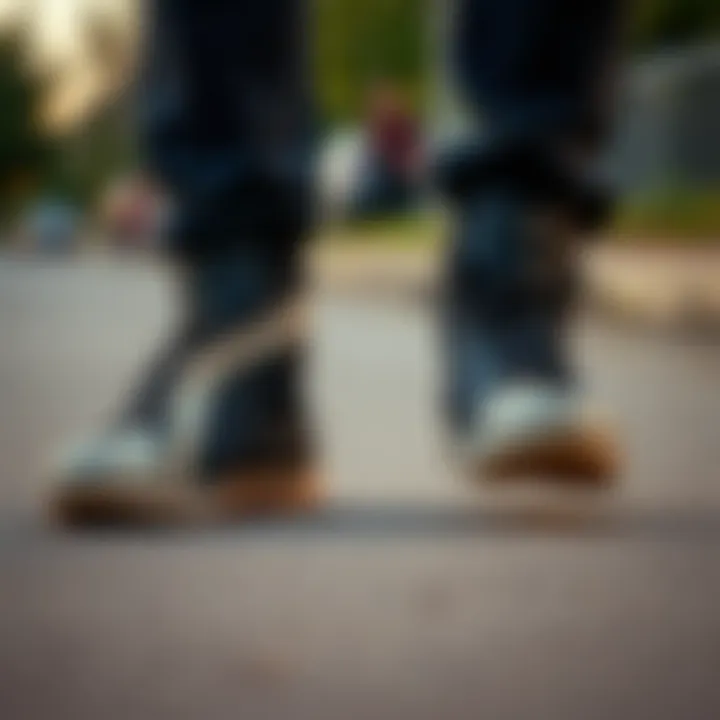
This blend of art and skate culture serves multiple purposes. First, it elevates the status of skate shoes to that of collectible items. Skaters don’t just wear them; they showcase them, embracing the crossover appeal that art brings into their daily lives. Secondly, it promotes dialogue between skate culture and the art world, creating broader recognition for both arenas.
These partnerships also fortify community ties among skaters. Limited releases create excitement and anticipation—somewhat akin to a treasure hunt where the reward is not just the shoes, but a sense of belonging within the skating community. The phrase "you had to be there" rings true as stories emerge from shared experiences at release events or social media posts about coveted finds.
As a result, the evolution of skate shoes is a reflection of both practical needs and cultural expression. Through the ups and downs, from classic designs to experimental collaborations, each shoe retains a footprint in the ongoing narrative of skateboarding culture.
"Every shoe tells a story; some are echoes of the past, while others are steps into the future of skating." – Skateboarding Enthusiast
The evolution in skate shoes illustrates how they shape skater identities, build community, and adapt to the ever-changing landscape of the sport. Ultimately, these shoes represent much more than gear; they signify the spirit of rebellion, artistry, and belonging that is essential to the culture.
Environmental Considerations of Skate Footwear
In today’s world, every industry faces the pressing need to reevaluate its environmental impact. Skateboarding, with its unique culture and community, is no exception. The environmental considerations of skate footwear delve into the sustainability practices being adopted to reduce ecological footprints while ensuring that style and functionality remain intact. This exploration not only touches on the innovations in production methods but also highlights the consequences of disregarding environmental responsibilities.
Sustainability in production and materials
The first step in understanding the environmental considerations of skate footwear is looking into the sustainable practices used in production. Traditional manufacturing methods for skate shoes often involve harmful chemicals and non-biodegradable materials. More brands are now shifting towards eco-friendly materials that not only lower the carbon footprint but also align with the values of conscious consumers.
Many skate brands are experimenting with materials such as recycled plastics, organic cotton, and natural rubber. These materials lessen dependency on conventional resources and cut down on waste significantly. As a skater, choosing shoes made from sustainable materials can affirm an individual’s commitment to protecting the environment while riding with the right gear.
Moreover, some companies have started introducing processes like water-based adhesives and dyes. Not only do these methods reduce harmful emissions, but they also significantly diminish water usage in the manufacturing process. It’s like the old saying, "every little bit helps." These small changes come together to create a larger impact.
Impact of discarded shoes on the environment
When we think about skate footwear, we often forget about what happens after the shoes have served their time. The impact of discarded shoes is substantial, contributing significantly to the global waste crisis. Skate shoes, typically made of a mix of synthetic materials, don’t biodegrade easily. This leads to piles of shoes ending up in landfills, where they can take decades, if not centuries, to break down.
The industry is starting to address this issue. Brands are now initiating take-back programs, allowing consumers to return their worn-out pairs. This is a win-win situation; skaters can responsibly dispose of old shoes, while companies can recycle materials to create new products, thus circling back to sustainability.
Here are some noteworthy points on the impact of discarded footwear:
- Landfill Overflow: A significant number of skater shoes contribute to landfill overflow due to their non-biodegradable nature.
- Substance Pollution: Chemicals leeching from footwear in landfills can contaminate soil and groundwater.
- Resource Wastage: Discarded shoes represent a waste of resources, from materials to energy used in production.
"Our choices matter; choosing sustainable footwear is not just a trend, it’s a statement."
Recognizing the environmental impact, skateboarding communities are becoming increasingly aware. It's a movement that embraces both the skate culture and the call for eco-friendly practices. A responsible approach toward footwear can help shape a greener future for the sport as well as for the world at large.
The Psychological Aspects of Fallen Shoes
Fallen shoes hold a unique place in the mind of a skateboarder, intricately woven into their identity and community. The dissection of the psychological aspects of these shoes reveals not just a preference for style or performance, but a deeper bond that goes beyond mere aesthetics. For many young skaters, footwear is not simply a tool for enhancing their sport; it reflects their personal journey, dreams, and social environment.
Attachment to Footwear and Identity Formation
In the world of skateboarding, a player's choice of shoes often serves as a personal statement. Most skateboarders have that one pair of fallen shoes they feel a kinship with—maybe it’s the way the laces fray just right or the unique pattern of scuffs that tells stories of countless tricks attempted. When a skater slips on a pair of fallen shoes, it’s like putting on their armor; they're ready to confront the usual grind of the deck, a symbol of their commitment to the craft.
Such attachment grows over time. A pair of shoes that's been through thick and thin often carries with it a narrative, a tapestry woven from adrenaline-fueled moments and painful falls. This connection is not just about physical comfort but intertwines with the skateboarding culture's rebellious spirit, allowing skaters to declare their allegiance to a lifestyle while communicating their individualism.
Fallen shoes often become a canvas for youth to project their personalities. Whether painted, scuffed, or embellished, each mark signifies a story, and that unique history resonates with others in the skateboard community. There is a powerful psychological gratification in exhibiting these shoes, a way to visually narrate their journey and experiences in a world fraught with challenges.
The Narrative of Wear and Tear
Every scratch, every mark on a pair of fallen shoes tells a story, echoing the motto that skateboarding is not just a sport but a way of life. The visible signs of wear and tear transform the shoes into artifacts of persistence, each crevice narrating the trials faced and strengths gained in the quest for mastery. For many, the evidence of their footwear’s journey becomes a badge of honor, a testament to their resilience.
Moreover, the narrative of wear and tear reflects the relationship skaters have with failure. Skateboarding is fraught with falls and failed attempts, yet, just as shoes endure, so do skaters. Each mark on their shoes sustains a deeper meaning—an acknowledgment that progression lies in persistence.
"In skateboarding, a worn pair of shoes embodies the journey, reminding us that falling down is part of standing back up."
As the shoes age and accumulate battle scars, they transition into symbols of growth and exploration in one's skating journey. The detachment from fresh, pristine footwear is common; scuffed shoes represent familiarity and comfort in a process where uncertainty reigns. Through this lens, the relationships skaters have with their fallen footwear underscores a broader psychological construct, framing skateboarding as not just an activity but a form of artistry and self-expression.
The Impact of Social Media on Skateboarding Footwear Culture
The confluence of social media and skateboarding culture has become an undeniable force, redefining how skaters connect, share, and influence one another. In the context of footwear, platforms like Instagram and TikTok have become not just showcases for tricks, but also galleries for sneaker lovers to flaunt their favorite kicks. The immediacy and reach of social media amplify trends and styles in ways that traditional marketing could only dream of. Through likes, shares, and comments, the digital space not only amplifies voices but also democratizes fashion within skateboarding.
Influencers and their role in shaping trends

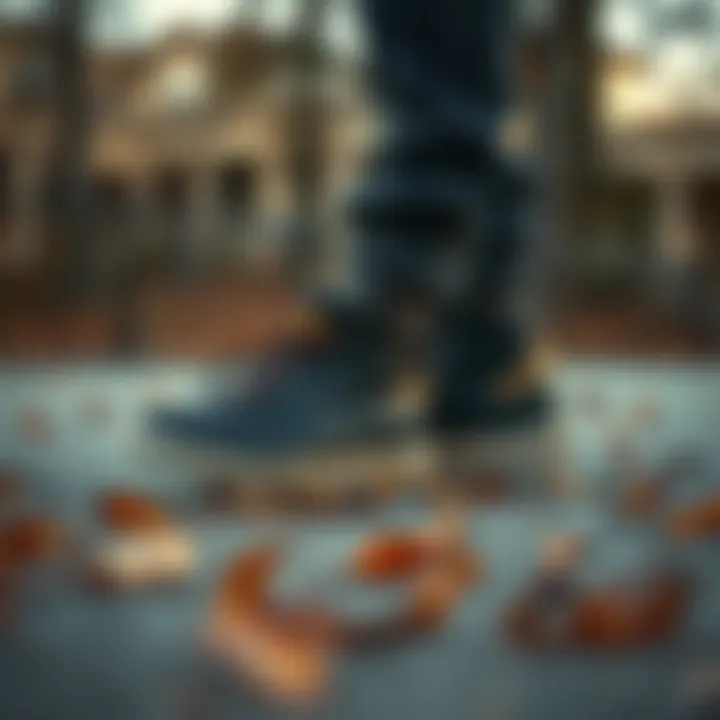
In today's world, influencers hold a significant sway in the realm of skateboarding footwear. A skater doesn't just skate—many also curate content that showcases their lifestyle, and footwear is a core element of that. These digital personalities have the power to turn a relatively obscure model into a must-have item overnight. For instance, when well-known skaters like Nyjah Huston or Leticia Bufoni wear a particular pair of shoes in their videos, it's like ringing the bell for a stampede. The followers, many of whom look up to these athletes for inspiration, rush to emulate their style. This has turned many skate shoes into limited edition treasures, often leading to sold-out stocks and resale price inflation.
Moreover, emerging influencers can find their niche and build a brand without a corporate banner flying over them. Platforms such as YouTube enable potential stars to post their own skate clips, build a following, and promote their favorite brands. The impact of influencers is not merely limited to the endorsement of brands; they foster a sense of community where skaters feel that they can express themselves through their choice of footwear, aligning with their personalities and riding styles.
"In the world of skateboarding, every pair of shoes tells a story, and social media is the megaphone amplifying those narratives."
The digital landscape and community engagement
The digital landscape serves as a bustling community for skaters and enthusiasts alike. Here, social media acts as both a platform for showcasing skill and a space for discussing the essence of skating culture and its artifacts, such as footwear. Various hashtags, such as #SkateShoes or #FallenShoes, allow users to congregate around shared interests.
This community engagement extends beyond simply putting up videos or pictures; it involves active dialogues about styles, comfort, and durability of skate shoes. Discussions could occur in comment sections or dedicated forums on platforms like Reddit or specialized Facebook groups, where users praise or critique specific brands and models. Anonymous sprightly skaters, sitting in their homes, can give their opinions about how a particular shoe holds up during a session at the park or how it feels during a long day of skating.
Additionally, challenges and trends emerge rapidly in this space. Something as simple as a shoe customization challenge can elevate a basic sneaker into an art piece, adding personal flair that speaks volumes about the wearer’s character. In this manner, social media serves not just as a tool for connection but as an enabler for creativity, allowing skaters to define themselves not just by their skills on the board, but by the shoes that accompany their journey.
Fallen Shoes and Youth Culture
The world of skateboarding is not just about tricks and boards; it stands as a canvas of self-expression for many youths. Within this vibrant culture, fallen shoes hold a significant place, symbolizing much more than just a piece of footwear. They encompass layers of identity, experience, and social dynamics that resonate deeply with young skaters. For many, the act of using and ultimately wearing out a pair of shoes is intertwined with feelings of accomplishment, resilience, and community.
A rite of passage for young skaters
Many young skaters see the act of wearing and subsequently 'falling' their first pair of skate shoes as a rite of passage. This process symbolizes growth and commitment to the craft. When a skater manages to break in their shoes, it’s not just about the footwear but also about accumulating experiences and skills.
The visual evidence of wear, such as scuffs, creases, and frayed laces, becomes a badge of honor—marking the skater's journey. Each nick and tear tells a story; the shoes become intertwined with personal memories of epic sessions with friends, fierce competition, and even the occasional mishap. When kids explain their shoe's faded hues, they are sharing a part of their skateboarding narrative with others, creating bonds that resonate in their community.
In an environment where style and attitude often define a skater, fallen shoes speak to authenticity and commitment. New skaters typically experience a natural inclination to mimic the footwear styles of their heroes, which brings a deeper understanding of this footwear's symbolic significance.
"Fallen shoes are like trophies. You wear them with pride because they represent what you've been through on the board."
Parental perceptions of skating footwear
On the flip side, parental views on skate shoes can significantly shape how young skaters experience their passion. Parents may grapple with several concerns regarding skate footwear: durability, safety, and social influence. The concern often arises from the visibility of skate culture in society, which occasionally carries a stigma of rebellion and nonconformity.
Parents generally want to ensure that their children are wearing shoes that provide the best support and protect their feet. Many miss the emotional and cultural significance that these shoes hold for their children. The constant battle between practicality and a child's desire for style creates tension at home.
The evolution of skate shoes has also stirred confusion. With brands like Vans or Nike SB pumping out designs that blend performance with aesthetic appeal, parents often struggle to keep up with what's trending. This gap in understanding can lead to clashes over choices. Parents might fail to realize their children are not just following trends; they’re engaged in a subculture that offers them identity and belonging.
Conversely, some progressive parents embrace skate culture and recognize the importance of fallen shoes as an entryway into learning about their child's interests. They begin to appreciate how this footwear symbolizes community involvement, creativity, and self-assertion rather than simply being a focus on style or expense.
Ultimately, the narrative surrounding fallen shoes serves as a mirror to the complex dynamics between youth and parents, melding creativity with concern, identity with misunderstanding. As generations intertwine their shoes onto the same streets, conversations on culture, artistry, and family ideals continue to evolve.
Finale: The Lasting Legacy of Fallen Shoes
In the world of skateboarding, the narrative surrounding fallen shoes is both rich and multifaceted. The term itself evokes various emotions, practices, and traditions that extend well beyond the mere functionality of footwear. Fallen shoes are more than mere articles of clothing; they are artifacts embedded with stories, experiences, and identity. Their legacy permeates skateboarding culture, creating a tapestry that intricately connects skaters to their community and history.
Fallen shoes symbolize resilience and adaptation. Each scuff and mark tells a tale of triumph, failure, and growth—reflecting the essence of skateboarding itself. When skaters hit the pavement with their chosen kicks, they are not just participating in a sport; they are making a statement about who they are and what they represent. To some, it might be a badge of honor, a testament to hours spent honing their craft, while to others, it's a means of self-expression, a vehicle for creativity and individuality.
Across generations, the cultural significance of these shoes has evolved but remains rooted in core values shared by the skate community. The act of choosing a skate shoe often wades into deeper meanings about belonging and defiance against mainstream fashion norms. It is this layering of symbolism that persists, where each pair fallen in the line of duty carries with it the weight of collective experience.
"Every worn shoe tells a story, a reflection of the dedication and struggles faced on the board."
Many young skaters view fallen shoes as a rite of passage. The first pair, abused and battered, becomes a cherished emblem of their journey, while parents may feel ambivalence, aligning practical concerns with the desire to understand their child's passion. It highlights a generational divide where charm lies in different places.
Overall, the lasting legacy of fallen shoes in skateboarding culture can't be overstated. They’re a fusion of performance, identity, and individual narrative threading throughout the community. As skateboarding continues to evolve, understanding this symbolism will provide a lens through which we can explore the nuances of not just skate culture, but also the broader community dynamics at play.
Revisiting their cultural significance
When skaters revisit the importance of fallen shoes, they delve into the social fabric that binds them together. Each brand and style signifies a different culture or statement, enriching the diversity within the skateboarding community. Popular models, such as the Vans Old Skool or Nike SB Dunk, have become not just functional choices but cultural touchstones that resonate deeply with skaters worldwide.
Shoes often prompt nostalgia; older skaters frequently reminisce about their first pair, which offered them the confidence to try their first kickflip or the freedom to skate the streets without reservation. This connection extends beyond the shoes themselves and into the realm of shared experiences.
Furthermore, the symbolism associated with fallen shoes often invites a dialogue about the commercialization of skate culture. As brands strive to innovate while remaining true to the roots of skating, discussions surface around authenticity versus consumerism. Striking a balance between maintaining honesty in their heritage while exploring modern trends is a critical conversation among skaters. The meaning behind each pair of shoes underscores their personal connection to the sport, which remains steadfast.
Future implications for skateboarding culture
As skateboarding gains mainstream recognition, the implications of fallen shoes remain dynamic. With the rise of sustainability concerns and eco-friendly brands, the skate community is beginning to see a shift towards more responsible choices. Footwear that aligns with environmental values may become a defining attribute of future trends.
Moreover, the continued integration of technology into footwear—smart shoes that track performance or adapt to individual foot shapes—could revolutionize the experience skaters have with their gear. However, this innovation must not come at the expense of the individuality that fallen shoes represent.
From a cultural standpoint, as skateboarding continues to influence various aspects of fashion, art, and lifestyle, fallen shoes will remain pivotal in signifying the rebellious spirit of skating. The community’s ability to adapt to changing times while honoring their roots will likely dictate the future landscape of skate culture.
In essence, analyzing the legacy of fallen shoes prepares the ground for understanding the ongoing evolution of skateboarding culture. It challenges enthusiasts, brands, and community leaders alike to keep the conversation going as they look to the future.



